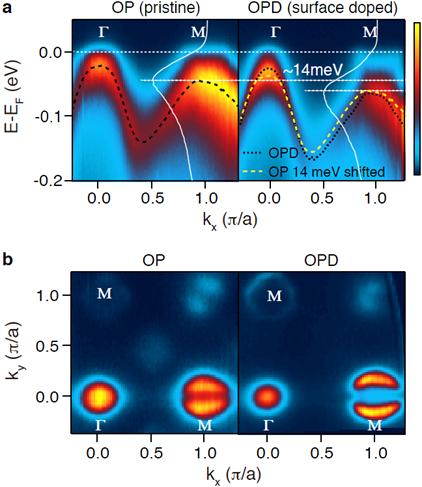Enhanced electron doping on iron superconductors discovered

Before and after the attachment of alkaline metals to the surface of iron-based, pniktogen superconductors. (a) Quantity of momentum of electrons (X) and kinetic energy of electrons (Y) before and after the electron doping : electron doping has changed the distribution of electron kinetic energy. (b) Fermi surface data before and after the electron doping: nesting condition has been weakened. Credit: IBS
The IBS research team headed by the associate director of CCES, KIM Chang Young, presented the possibility of unifying theories to explain the working mechanism of iron- based superconductors. Their research was published in Nature Materials on August 16th. Superconductors are a relatively new concept; they were brought to prominence in the late 80's when two Nobel Prize winners discovered a new superconducting material. The basic principle of superconductivity arises when a superconducting material is cooled to a fairly low critical temperature allowing an electric current to flow without resistance.
Building on a Nobel Prize
The Nobel Prize winners reported their superconducting material – oxides which contain copper and rare earth metals – becomes a superconducting material below -250° Celsius, higher than the previous temperature of -269° Celsius. This led to a boom in developing similar materials for commercial use. Today's research has moved on greatly; oxides are replaced with iron-based superconductors which are cheaper to mass produce and also permit a current to flow unabated. To understand the working mechanism of iron-based superconductors scientists have to significantly raise the transition temperatures to source the reason for the increase. Many researchers initially work on the assumption that the nesting effect is a dominant factor, especially in the case of pnictide superconductors {PSD}. Later, scientists discovered another type of superconductor, chalogenide superconductors {CSD}. Since it turned out that CSD is not subject to the nesting effect, the discovery of CSD generated controversy on the mechanism of their superconductivity. The nesting effect states when the surface temperature is increased, electrons become unstable thereby altering their properties both electrically and magnetically, allowing conductors to turn into superconductors.
Rewriting theories with peripheral electrons
Working under the assumption that a strong nesting effect in PSD corresponds to high temperature, the CCES team used potassium (K) and sodium (Na), two alkaline metals with peripheral electrons, thereby facilitating an easy transfer of electrons to other metals. They heated K and Na in a vacuumed environment to excite their atoms whereby the atoms attached to the surface of PSD, which have a lower temperature than the K and Na. As a result electron doping took place on the surface of PSD. The IBS team measured the momentum and kinetic energy of electrons and revealed, for the first time, that there is, in fact, no correlation between superconducting transition temperature and the nesting effect in PSD as is the case in CSD.
Associate director Kim Chang Young said, “Up to now the prevailing theory of PSD and CSD have been thought of as two different systems. Our research is a starting point to confirm that those two superconductors have the same working mechanism, we have laid a cornerstone for the discovery of iron-based superconductors, whose production cost is low and has no restraints in its current.”
Media Contact
All latest news from the category: Materials Sciences
Materials management deals with the research, development, manufacturing and processing of raw and industrial materials. Key aspects here are biological and medical issues, which play an increasingly important role in this field.
innovations-report offers in-depth articles related to the development and application of materials and the structure and properties of new materials.
Newest articles

A universal framework for spatial biology
SpatialData is a freely accessible tool to unify and integrate data from different omics technologies accounting for spatial information, which can provide holistic insights into health and disease. Biological processes…

How complex biological processes arise
A $20 million grant from the U.S. National Science Foundation (NSF) will support the establishment and operation of the National Synthesis Center for Emergence in the Molecular and Cellular Sciences (NCEMS) at…

Airborne single-photon lidar system achieves high-resolution 3D imaging
Compact, low-power system opens doors for photon-efficient drone and satellite-based environmental monitoring and mapping. Researchers have developed a compact and lightweight single-photon airborne lidar system that can acquire high-resolution 3D…





















